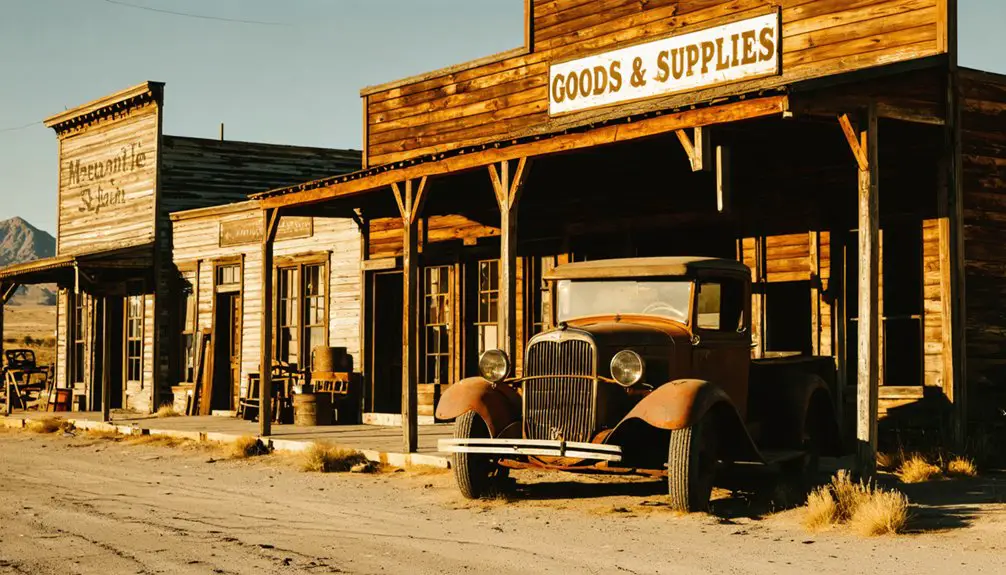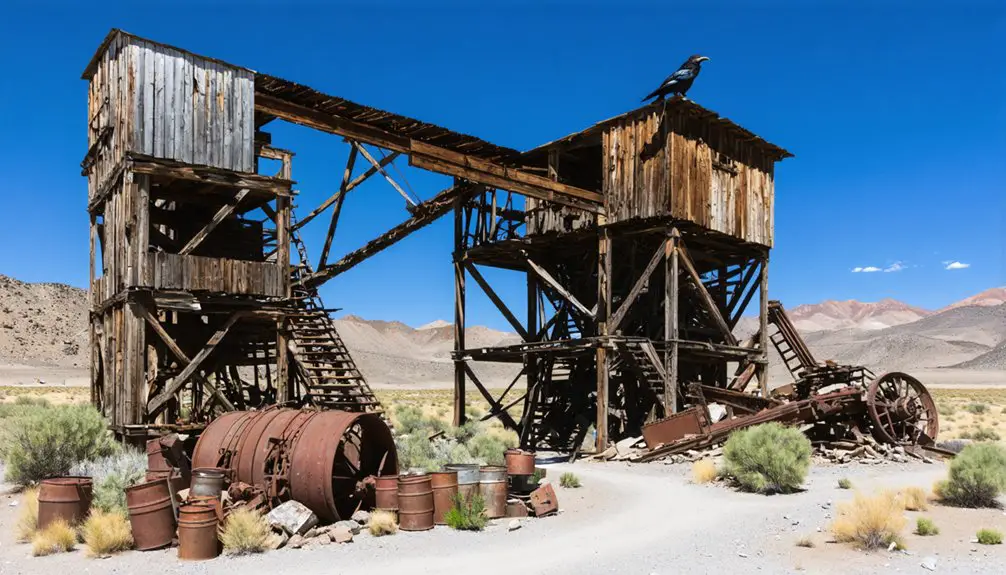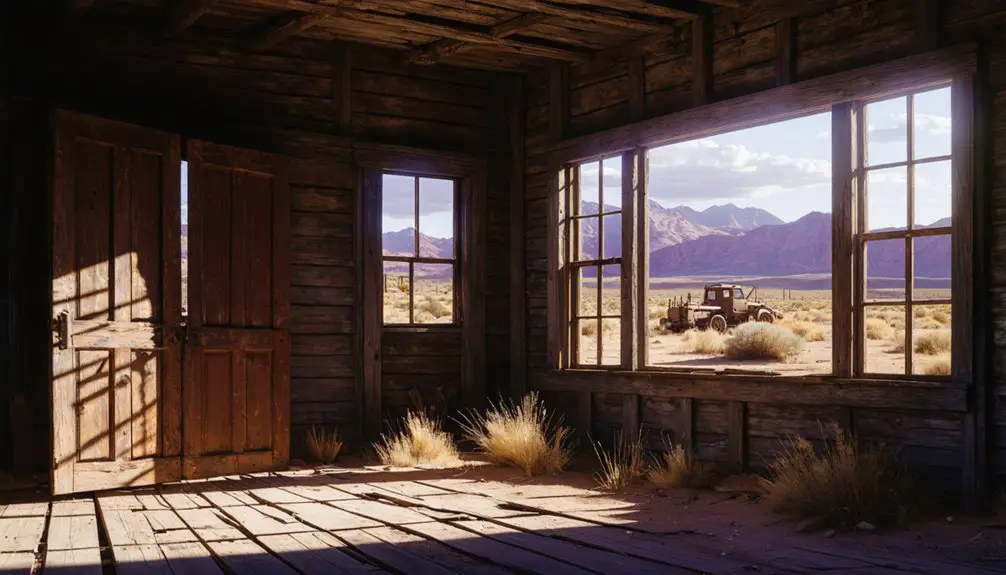You’ll find San Juan’s ghost town remnants near present-day Nelson, Nevada, where ambitious miners established a settlement in 1862 after discovering silver in Eldorado Canyon. Despite high hopes, the camp lasted only three weeks when prospectors realized the silver veins were too shallow for profitable mining. Today, just one stone building remains standing as evidence to this brief chapter in Nevada’s mining history. The site’s untold stories still echo through its weathered walls.
Key Takeaways
- San Juan (Upper Camp) was a short-lived Nevada mining settlement established in 1862 near present-day Nelson, following silver discoveries.
- The ghost town’s only remaining structure is a single stone building featuring expert construction and an arched fireplace.
- Mining operations declined rapidly after miners discovered silver veins were too small and shallow for profitable extraction.
- Despite revival attempts between the 1930s and 1950s, the settlement remained abandoned due to limited mineral resources.
- San Juan is among Nevada’s least-preserved ghost towns, with no formal preservation efforts or historic site designation.
The Rush for Silver: Discovery in Eldorado Canyon
While Spanish explorers ventured into Eldorado Canyon in 1775 searching for gold, they initially found only modest silver deposits at the Colorado River mouth.
You’ll find that they quickly abandoned their settlement at Eldorado, leaving the region’s richest silver veins undiscovered for decades.
Everything changed in the 1850s when a new wave of prospectors introduced modern mining techniques, including sluicing the Colorado River’s tributary streams.
Modern mining methods revolutionized the canyon in the 1850s as prospectors brought new techniques to extract wealth from Colorado’s waters.
By 1858, steamboats from Yuma made the canyon more accessible, triggering an influx of fortune seekers.
The Techatticup Mine’s tunnels stretched an impressive 500 feet underground as miners extracted precious metals.
Your timing would’ve been perfect in 1861 when John Moss and others struck it rich, discovering valuable lodes of silver, gold, and copper.
The area’s lawless reputation grew as Civil War deserters sought refuge in the canyon’s remote terrain.
This discovery sparked the formation of major operations like the Southwest Mining Company and El Dorado Mining Company, forever transforming the canyon’s destiny.
Life in Upper Camp: A Brief Settlement Story
The silver rush in Eldorado Canyon spawned numerous settlements, including the short-lived Upper Camp, also known as San Juan. You’ll find its remnants near present-day Nelson, Nevada, where a solitary stone building marks the 1862 settlement site.
Community dynamics centered around mining operations, with workers living in makeshift camps several miles from the Colorado River. Daily routines revolved around extracting silver from small ore veins while relying on steamboat deliveries for essential supplies. Like its namesake Saint John in Spanish, the settlement held cultural significance for its predominantly Hispanic miners. As with many place name duplicates, the location caused confusion among travelers and mapmakers of the era.
Despite the miners’ efforts, the settlement’s remote location and challenging terrain made sustained living difficult. Within weeks of its establishment, you would’ve witnessed the rapid exodus of miners as the limited silver veins proved unprofitable.
While neighboring camps in Eldorado Canyon prospered during the Civil War era, Upper Camp’s brief existence ended almost as quickly as it began.
Transportation and Trade Along the Colorado River
The transportation evolution continued as Lee’s Ferry emerged in 1864, providing the only crossing point for hundreds of miles until Navajo Bridge‘s construction in 1928.
You could’ve witnessed the shift from water to rail transport when the Denver and Rio Grande Western Railroad completed the “Dotsero Cutoff” in 1931, connecting Denver to Salt Lake City.
The river’s historic role as a territorial boundary between the Navajo and Ute peoples influenced early trade routes and crossing points. This rail expansion changed everything, though river transport remained essential for mining operations and military supplies until modern infrastructure took hold. The river system’s extensive network of dams and reservoirs transformed the Colorado’s natural flow, permanently altering transportation patterns in the region.
Mining Operations and Economic Challenges
Mining fever struck San Juan Ridge in 1851 when prospectors discovered placer gold, launching an era of intensive hydraulic operations that would last until 1884.
The area’s lower blue lead contained the richest gold deposits, with gravel layers reaching up to 140 feet in thickness. You’ll find that hydraulic mining techniques dominated the landscape, removing up to 150 feet of gold-bearing deposits around the Columbia Hill Mine. In 1995, a catastrophic flooding event disrupted modern mining attempts in the region.
- The 1884 Sawyer Decision banned debris discharge into rivers, effectively ending large-scale hydraulic mining.
- Chinese miners continued small-scale placer operations through the early 1900s.
- Economic impact was significant, with over 165 million cubic yards of unexploited deposits remaining by 1919.
Later attempts to revive mining included 1960s government exploration and Placer Service Company’s 1979 venture, but declining gold prices and local opposition proved challenging.
The Stone Building: Last Standing Sentinel
When you visit San Juan today, you’ll find the stone building’s enduring masonry work stands as evidence to 19th-century construction techniques in Nevada mining camps.
The structure’s robust stone walls, built to withstand harsh desert conditions, contrast sharply with the wooden shelters that once dominated the landscape but have long since vanished. Much like the historic San Cristóbal fort in Puerto Rico, this building was constructed to endure the test of time. The site represents one of many abandoned boomtowns that dot Nevada’s landscape.
Its survival showcases the superior craftsmanship of early miners who chose permanent materials over temporary solutions, even in what proved to be a short-lived settlement.
Architectural Features Preserved
Standing as a solitary monument to San Juan’s brief mining era, a remarkable stone building remains the last major structure from this Nevada ghost town’s 1862 settlement.
The building’s architectural craftsmanship sets it apart from typical mining camp structures, featuring robust stone masonry that’s withstood decades of harsh desert conditions.
- Four complete stone walls showcase expert construction techniques, creating a self-supporting structure that’s outlasted its wooden contemporaries.
- An artistic arched fireplace serves as the interior’s centerpiece, demonstrating uncommon attention to detail for a frontier mining camp.
- The building’s solid construction and high-quality stonework represent a rare example of permanent architecture in what was intended to be a temporary settlement.
The structure’s preservation offers you a unique glimpse into the ambitious vision of early Nevada’s mining pioneers.
Historical Construction Methods
Built during the silver rush of 1862, San Juan’s remarkable stone building showcases the sophisticated construction methods employed by frontier builders.
You’ll find historical techniques that combined locally quarried stone with lime-based mortar, creating thick walls designed to withstand Nevada’s harsh climate and frequent fires.
The masonry methods reflected both practicality and engineering wisdom. Builders used larger foundation stones to support the heavy walls above, incorporating an inward batter for increased stability.
They’ve crafted window and door openings with sturdy stone lintels, while the walls’ substantial thickness provided natural insulation against extreme desert temperatures.
The use of nearby stone sources kept transportation costs low, while the dry-stacking technique, common in mining regions, allowed for rapid construction during the town’s brief but hopeful boom period.
Geographic Features of San Juan Creek
San Juan Creek carves a 29-mile path through Orange and Riverside Counties in California, draining a watershed of nearly 134 square miles before reaching the Pacific Ocean.
The creek’s dynamics are shaped by complex geological forces, including seismic activity from the Cristianitos and Mission Viejo fault zones.
You’ll find highly erosive sedimentary soils throughout the watershed, creating dramatic landscapes and substantial alluvial deposits.
- The creek’s course follows ancient fault lines, cutting through steep canyons and coastal terrain.
- Erosion impact is particularly visible in the region’s landslide-prone hillsides, which can collapse during heavy rains.
- The San Joaquin Hills act as a natural barrier, influencing the creek’s flow patterns and sediment transport.
The Rise and Fall: A Three-Week Wonder

You’ll find that San Juan’s meteoric rise began in 1862 when silver was discovered along the upper San Juan Creek, prompting a rush of prospectors to establish a mining camp.
Within weeks, miners realized the silver veins were too small and shallow to sustain profitable operations, despite having steamboat access on the Colorado River for ore transport.
The camp’s swift abandonment left only a single stone building standing, though later revival attempts between the 1930s and 1950s proved equally unsuccessful.
Swift Settlement Surge
Following the brief Fraser River gold rush of 1858-1859, a dramatic transformation swept across San Juan Island as disappointed prospectors turned to homesteading for stability.
You’ll find that by mid-1859, around 18 American settlers had established farms, challenging the British Hudson’s Bay Company’s traditional grazing lands and triggering fierce settler conflicts over land ownership.
- The rapid influx intensified when miners, seeking new opportunities, flooded the island within weeks during summer 1859.
- Territorial disputes erupted after American settler Lyman Cutlar shot a British-owned boar, leading to threats of arrest and eviction.
- The surge prompted both nations to deploy military forces, with Captain George Pickett arriving with U.S. troops to protect American interests.
This swift settlement transformed the island from a sparse British outpost into a contested frontier within just three weeks.
Mining’s Rapid Decline
While American settlers were establishing their presence on San Juan Island, the region’s mining industry experienced a dramatic reversal of fortune.
You’ll find that by the late 1870s, mining operations sharply declined, with the Manzanita Mine’s production dropping to $174,000 in 1878. As mining techniques evolved from hydraulic to underground methods, challenges mounted.
The environmental impact became severe, with mining debris damaging waterways and domestic wells running dry from fractured aquifers.
The California Debris Commission Act of 1893 dealt a final blow, restricting hydraulic mining despite vast gold reserves remaining 300-500 feet below ground.
Though sporadic mining continued through World War I with Guggenheim backing, the combination of depleted surface deposits, rising operational costs, and stringent regulations transformed San Juan from a bustling mining hub into a ghost town.
Preservation Status and Historical Significance
Despite its historical role in Nevada’s 1862 silver rush, San Juan ghost town exists today with minimal preserved structures, featuring only a single large stone cabin at the original site.
Unlike better-preserved ghost towns such as Rhyolite or Goldfield, you’ll find San Juan faces significant preservation challenges, with most of its mining heritage lost to time and the elements.
The site’s historical documentation primarily exists in books and registries rather than physical remains:
- No formal preservation efforts or historic site designation protect the area
- Multiple post-abandonment mining attempts failed to revive the settlement
- Environmental exposure continues to deteriorate what little remains
Today, San Juan ranks among Nevada’s least-preserved ghost towns, offering limited educational or tourism value compared to locations where active preservation programs maintain historic structures.
San Juan’s Role in Nevada’s Mining Heritage

The rich placer gold deposits at San Juan Ridge sparked California’s earliest mining activities in 1851, establishing the area’s significance in Western mining history.
You’ll find that mining techniques evolved rapidly here, from simple placer operations to extensive hydraulic mining that removed the upper 100-150 feet of auriferous gravel by the mid-1850s.
The historical impact of San Juan’s mining operations extended well beyond the Sawyer decision of 1884, which restricted hydraulic mining.
San Juan Ridge’s mining legacy transcended the landmark Sawyer ruling, shaping California’s environmental and economic trajectory for generations to come.
Chinese miners continued small-scale operations into the 1900s, while major companies conducted extensive explorations throughout the 20th century.
The area’s massive untapped deposits, estimated at hundreds of millions of cubic yards and lying 300-350 feet below surface, represent one of the Sierra Nevada’s largest remaining gold resources, though modern mining efforts have faced community resistance.
Archaeological Findings and Remaining Artifacts
Limited archaeological evidence remains at San Juan Canyon ghost town, where you’ll find just one large stone cabin as the primary physical remnant of its mining history. The site’s artifact scarcity reflects its brief operational periods in 1862, the 1930s, and 1947-1950, with minimal establishment of permanent infrastructure.
- Archaeological significance is limited due to harsh desert conditions that have accelerated artifact deterioration.
- No mining equipment, processing facilities, or housing foundations survive at the site.
- Unlike artifact-rich Nevada ghost towns such as Rhyolite or Jarbidge, San Juan lacks substantial material culture.
The absence of extensive artifacts aligns with historical records suggesting short-lived mining ventures and rapid abandonment.
You’ll need to rely primarily on mining documents and secondary sources to understand San Juan’s past, as physical evidence remains scarce.
Frequently Asked Questions
Are There Any Paranormal Activities Reported at the San Juan Ghost Town?
You’ll find ghost sightings and unexplained noises reported around old mine shafts and deserted cabins, though notably, most claims remain unverified despite the town’s rich history of mining accidents.
What Happened to the Original Mining Equipment and Tools After Abandonment?
You won’t find any abandoned machinery or mining relics today – they were quickly removed, salvaged, or deteriorated after the mine’s closure. Equipment was either repurposed elsewhere or taken by scavengers.
Did Any Notable Historical Figures Visit San Juan During Its Operation?
You won’t find any famous visitors or significant historical events documented during San Juan’s brief weeks of operation. Historical records show no notable figures ever made their way to this short-lived camp.
What Was the Estimated Total Population During San Juan’s Peak Mining Period?
While exact numbers aren’t recorded, you’ll find estimates suggesting a few hundred residents during the mining boom, before rapid population decline struck within weeks of the settlement’s 1862 establishment.
Were There Any Conflicts With Native American Tribes in the Area?
Like storm clouds gathering before rain, Native American Relations in the area were tense. Historical Conflicts included the Posey War, where you’d find Ute and Paiute tribes clashing with white settlers.
References
- https://kids.kiddle.co/San_Juan
- https://en.wikipedia.org/wiki/San_Juan
- https://nvtami.com/2024/07/24/las-vegas-ghost-towns/
- https://en.wikipedia.org/wiki/List_of_ghost_towns_in_Nevada
- https://nevadacountyhistory.org/videos/?Name=Nevada+County+Ghost+Towns+Video+with+Bernie+Zimmerman
- https://www.legendsofamerica.com/nv-eldorado/
- https://travelnevada.com/ghost-town/exploring-eldorado-canyon/
- https://en.wikipedia.org/wiki/El_Dorado_Canyon_(Nevada)
- https://special.library.unlv.edu/boomtown/counties/clark.php
- https://nevadamagazine.com/issue/january-february-2014/1073/



